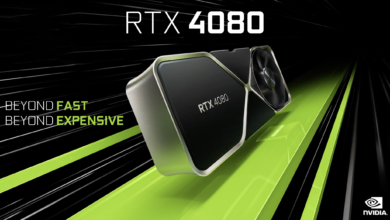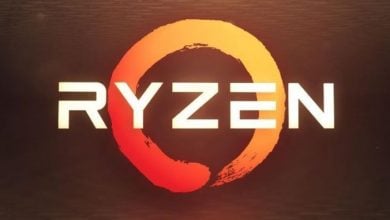A Deep Dive Into Intel’s Present and the Future
Intel is probably best known for introducing the first ever microprocessor in 1971 termed ‘Intel 4004‘. The giant, since then has made leaps in technology and has built quite a reputation in the past 50 or so years. However, their competitor AMD, despite being on the brink of bankruptcy made one of the biggest comebacks in history. Intel even after 6 years since the launch of Ryzen has been slow to respond, but is this the turning point?
How It All Started
Back in the 2000s (Technically 1999), AMD unleashed its Athlon and Opteron CPUs to combat Intel’s Pentium offerings. Well, guess what, they actually managed to beat Intel, and not by a small margin. Athlon was the first architecture to hit 1GHz which led to AMD actually beating Intel. The Opteron server offerings were in fact, much faster than Intel’s Xeons.
This spelled trouble for Intel’s market share and is probably why you will hear old-school tech enthusiasts say that Ryzen is not the first architecture to steal Intel’s performance crown. AMD and Intel got extremely close in terms of market share where AMD even overtook team blue for some time. This is not something you hear commonly.
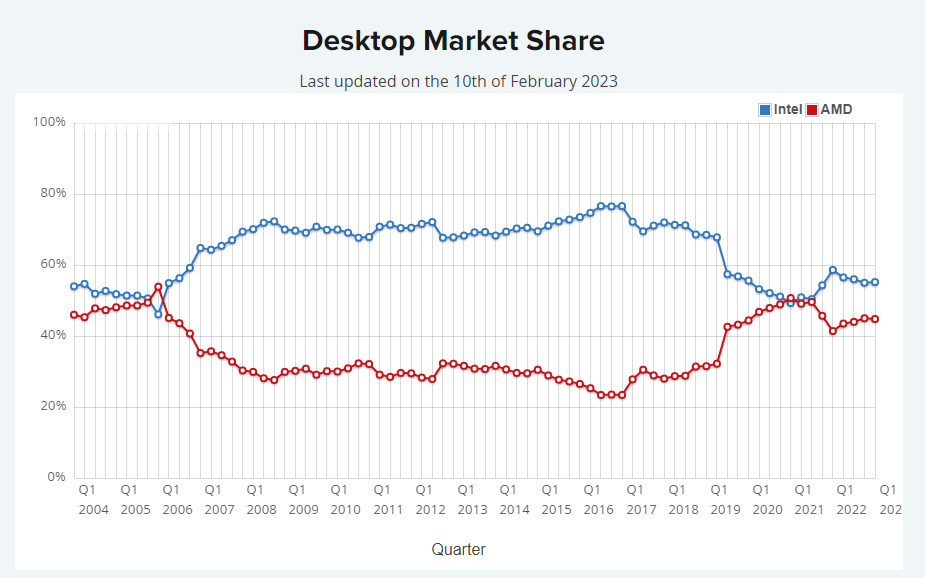
However, all good stories eventually come to an end. Intel released ‘The Core 2‘ in 2006 and this is when things took a turn for the worse for AMD. Their recent acquisition of ATI and failure in the CPU department led them to near bankruptcy. In 2015, analysts started to speculate that AMD was at a point of no return and would eventually face bankruptcy.
Surprise surprise, someone decided to make a comeback in 2017 with one of the best architectures in CPU history. Meet Ryzen. This series of CPUs utilized the Zen architecture which initially was a 52% improvement over its predecessor. Further improvements were made through Zen+ but Zen2 was the real deal.
Zen2 was AMD’s answer to Intel’s high-core count CPUs. Instead of relying on a single chip, AMD splits its CPUs into 2 dies. This is probably better known as a multi-chiplet design. When you use newer and more expensive nodes, physical interfaces will not scale as well as other components. Therefore, a multi-chiplet design enables manufacturers to fabricate these interfaces using a cheaper yet cost-effective process.
Not All Nodes Are the Same
It is important to note that this is the point where Intel should have introduced its 10nm process node. However, Comet Lake (10th Generation) was based on a 14nm process. In fact, 14nm was introduced back in 2015. The first actual (desktop) 10nm class (Intel 7) product was from Alder Lake, launching in 2021. Well, let’s talk about process nodes for a second.
Intel’s 14nm process node packs 37.5 Million transistors per square millimeter. In contrast, TSMC’s 12nm node carries around about 33.8 Million transistors per square millimeter. But wait, Zen2 was based on a 7nm process from TSMC. The base N7 process is equipped with 91.2 Million transistors per square millimeter.
On the contrary, Intel’s 10nm process now termed ‘Intel 7‘ features 100.76 Million transistors per square millimeter. Technically, this is why Intel managed to be on par with AMD with an older process. The actual advantage came to Intel with Alder Lake, that’s why you saw the drastic jump in performance.
To give you an idea of the yield problems Intel faced in the production of 10nm, Tiger Lake (Mobile 11th Gen) was fabricated on a 10nm process. What about Rocket Lake (Desktop 11th Gen)? The yields were apparently so bad that Intel could not afford to manufacture their 11th desktop generation on a 10nm node. Instead, they opted for 14nm, yet again. Transistor density does play a role here, but for how long?
Why Intel 4 Matters
AMD unveiled Zen4 last year, built on TSMC’s 5nm process. Intel on the other hand revealed Raptor Lake, where most Non-K SKUs are merely Alder Lake refreshes. We’ll get into the architecture in a bit. But TSMC’s 5nm process packs 38% more transistors per unit area as compared to Intel 7. Let that sink in for a moment.
| Metric | Intel 14nm | TSMC 12nm | Intel 7 (10nm) | TSMC 5nm | Intel 4 (7nm) | TSMC 3nm |
| Transistor Density (MTr / mm2) | 37.5 | 28.88-33.8 | 100.76 | 138.2 | 160-200 | 180-220 |
There is a limit to everything. And Intel is also reaching the EOL for its Intel 7 process. This 38% density lead will only increase as Zen5 launches (TSMC 3nm?). It should be clear that team blue relies heavily on ‘Intel 4’. Should Intel 4 be delayed, it will end up being disastrous for the giant. Luckily for Intel, they may have around 6-7 months of time to fix Intel 4 in case it gets delayed. For reference, Intel 4 features 160 MTr / mm2 – 202 MTr / mm2 transistors.
Raptor Lake, Another Refresh?
Now, a generational leap does mean a newer architecture right? OneRaichu conducted a few IPC tests to compare the 13th Gen’s ‘Raptor Cove’ vs the 12th Gen’s ‘Golden Cove’ architecture. The difference is just 1.4%. Technically, Intel bumped up the clock speeds and increased the L2 cache across each P-core by 60%, and across each E-core cluster by 2x. Similarly, Raptor Lake features 2x more E-cores, leading to an almost 4x cache increase over the efficient cores.
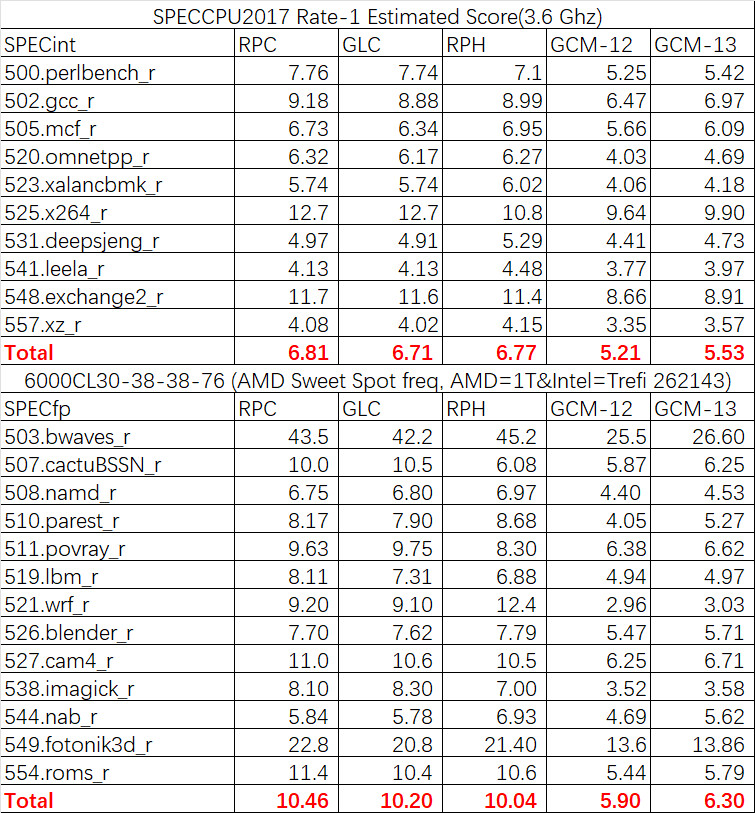
Zen4 on the other hand has an IPC improvement of around 12-14% over Zen3. Given the negligible IPC difference, a few Raptor Lake SKUs are actually hybrid and may feature Raptor Cove cores or Golden Cove cores. Below you can see an image of a listing where the i5-13400 can either be a 12th-gen offering or a 13th-gen offering.
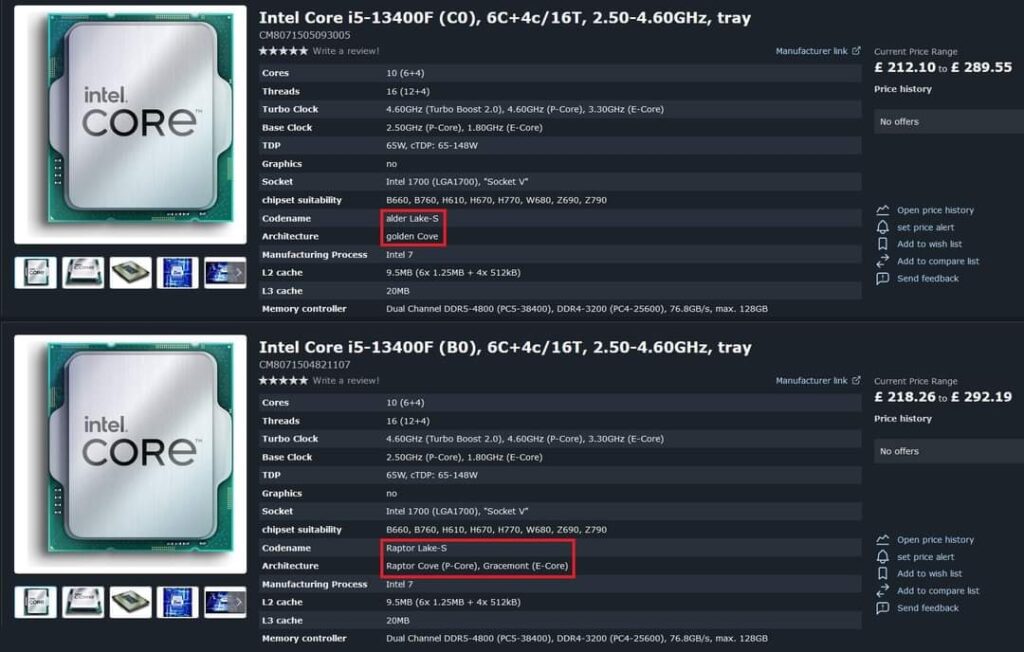
This inconsistency can, however, be explained by the minute difference between both architectures. As per MLID, Intel has 8+8 and 4+0 (i3-13100) Raptor Lake dies ready to be used in these CPUs. However, due to an Alder Lake oversupply, Intel now is forced to ship Golden Cove until inventory dries out. In short;
The difference between the 13400 (Raptor Cove) and the 13400 (Golden Cove) is probably not that major. Both Alder Lake and Meteor Lake utilize the same underlying architecture whereas Raptor Cove is hardly faster than its predecessor. The ‘huge’ generational leap you see on the K-SKUs is primarily due to the increased clocks and 2x more cache per each e-core cluster.
Abdullah Faisal
Raptor Lake Refresh (Alder Lake Refresh Refresh)
Hardware leaker HXL shared a number of slides from Intel highlighting future plans. One of these slides showcases Intel’s plan for a Raptor Lake Refresh this year. So in Q3 2023, Intel plans to unveil Raptor Lake part 2, but what exactly has improved? Is it a newer architecture? Extremely unlikely as Intel probably would not want to make more dies and besides, Redwood Cove is said to be used in Meteor Lake which is (also) facing some problems (Read our previous coverage for more insight).
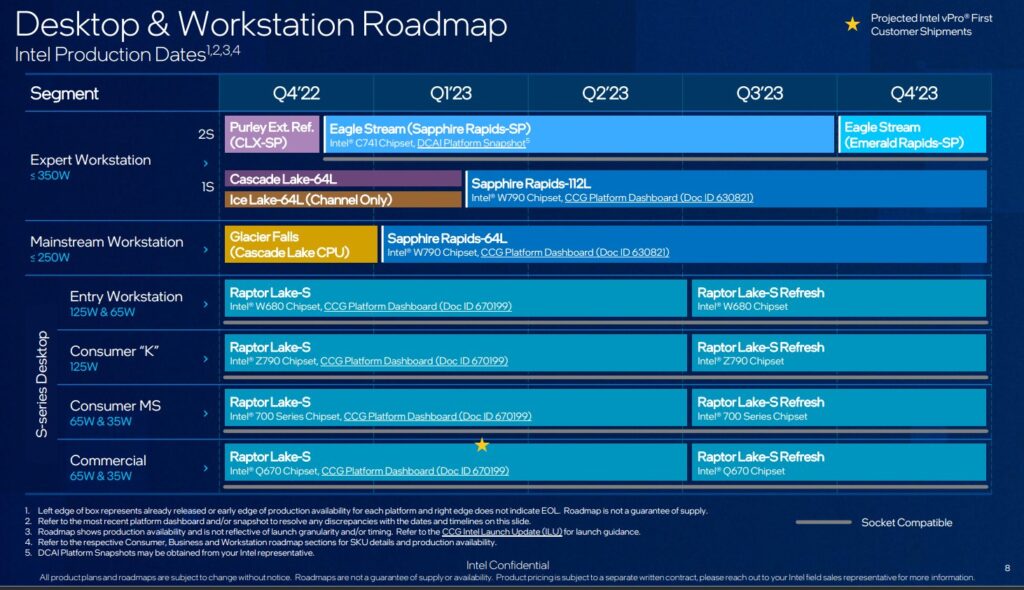
Is this stagnation? Technically no because Intel does not plan for another CPU until Q4 23/2024 when we are bound to see Meteor Lake (at least on mobile). ECSM (Post deleted) suggests that the Raptor Lake Refresh will be marginally faster as it can boost a few hundred megahertz higher than its counterpart. And that’s about it. This is probably Intel’s best reply to Zen4-X3D before 2024 where (if we are lucky) we may see a few i5/i7 MTL-S CPUs.
2023 is probably not going to be the best year for Intel. Sapphire Rapids is much slower than AMD’s Genoa and AMD is still yet to announce Bergamo in H1 2023. Intel may take the lead in the high-end mobile market but it still cannot reply to AMD’s Phoenix Point.
Sapphire Rapids, A Few Years Too Late?
Last month, Intel unveiled its Sapphire Rapids server CPUs termed ‘4th Generation Xeon Scalalabe Processors‘. These CPUs were meant to be an answer to AMD’s Milan, which launched in 2021. Oh did I mention that Intel had planned for SPR to succeed Ice Lake in 2021? Here’s a summary of the proposed release dates thanks to a user on Reddit:
- “Ship in 2021”
- “Early 2022”
- “Mid 2022”
- “2H 2022”
- “Ramp Sapphire later in this year….and throughout 2023”
Sapphire Rapids uses Golden Cove cores (Alder Lake) and is fabricated on the Intel 7 process. These CPUs offer up to 60 P-cores in contrast to AMD’s 96 cores (Genoa standard). The successor to Sapphire Rapids, Emerald Rapids will arrive later this year. It will be based on the Intel 7 process and may wield Raptor Cove P-cores.
A Possible Comeback
The real deal begins in 2024 and here’s where Intel will pull out its trump card. Granite Rapids is the next big thing after Sapphire Rapids. Alongside that, Sierra Forest is Intel’s reply to Bergamo. Intel is in the game, they have the processors, but can they deliver on time? You should see our previous coverage on these CPUs to understand how Intel has downgraded its CPUs.
Alright, alright, let’s start off with the initial rumors and expectations. Granite Rapids (AP) was and is still intended to feature 132 P-cores split across 3 tiles each containing 44 cores. What’s better? It will be based on the Intel 3 process (5nm EUV). GNR-SP will drop this core count to 88 (2 tiles) but that’s not a major decrease.
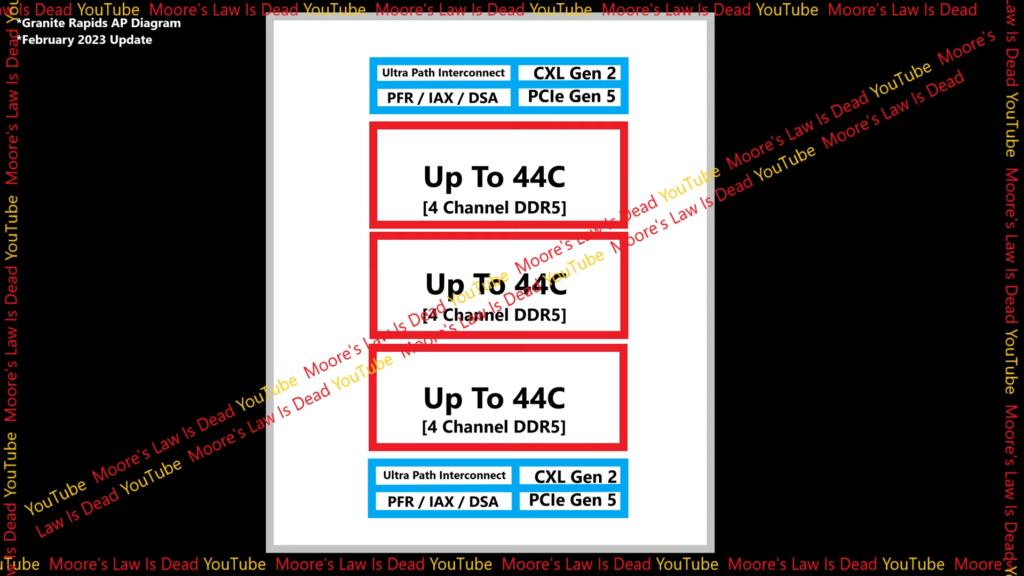
Take it like this, Intel is planning a 132-core monster based on Intel 3 and a 15-25% IPC offering Redwood Cove that is (as per Intel) 18% more efficient. That would probably rip apart Genoa and be a strong competitor against Turin.
On the other hand, Sierra Forest is an E-core-only CPU set to battle AMD’s Bergamo. Though, it is expected to arrive no less than 1 year from now. Sierra was initially planned for a 512-core configuration which has since been canceled. SRF-SP will feature 144 E-cores across a single tile, where its AP configuration could go as high as 288 cores (2 tiles). Not too shabby. That’s still 2.25x more than what Bergamo offers, so it may just be worth the wait. (Leak source: MLID)
- Fishhawk Falls 24C (Sapphire Rapids) – 2023
- Fishhawk Falls 36C (Emerald Rapids) – H2 2023
- Granite Rapids 88C (SP) / 132C (AP) – 2024
- Sierra Forest 144C (SP) / 288C (AP) (Crestmont) – 2024
- Sierra-Next (Skymont Cores) – 2024+
Meteor Lake, A Shot in the Dark
Meteor Lake has been rumored to be canceled by many leakers. However, the latest update from MLID mentions that the high-core count SKUs are not guaranteed anymore. Why? Intel has limited resources. If they go on and make a high core count i9-14900K, it will take away those resources. They need that money and RND to go into something that can contend against Strix Point and even Turin.
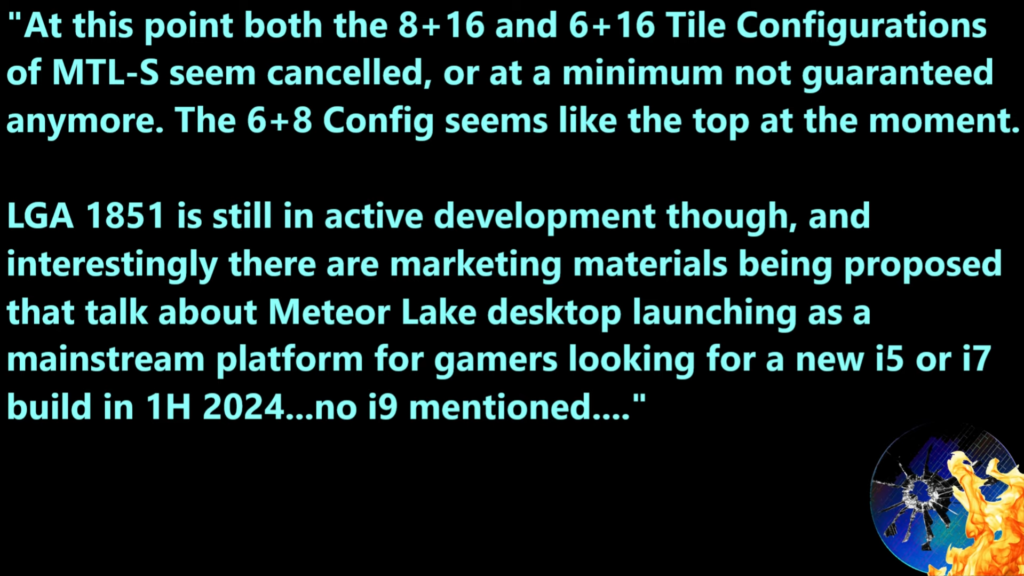
So the lineup will be like this. For gamers looking to upgrade to a newer platform (Which supports Arrow Lake and even possibly Panther Lake), Intel will offer the i3/i5/i7 MTL-S CPUs. For content creators, Intel will still rely on Raptor Lake Refresh to do its trick. If someone wants to future-proof their system, they can upgrade to an LGA 1851 motherboard and wait until Intel launches something like Arrow Lake. For Intel, mobile and server market shares matter much more than desktop. Here are the updated specs for MTL-S:
- LGA 1851 Socket
- Up to 14 Cores (6+8) | Redwood Cove/Crestmont architecture
- 15-25% Performance Core IPC Gain
- 15% Efficiency Core IPC Gain
- Focus on Efficiency
- 2023/24 Release Date
- Intel 4 Process (20% More Performance/Watt)
- 160 MTr / mm2 – 202 MTr / mm2
Arrow Lake & Plans Post 2024
Arrow Lake is the codename for Intel’s 15th generation of CPUs. It is rumored to be fabricated on the Intel 20A (2nm?) process, however, team blue may resort to TSMC’s 3nm node if things go south. The highest-end configuration we see with Arrow Lake is equal to Raptor Lake at 24 cores (8 Lion Cove Performance cores + 16 Skymont Efficiency Cores). Since MLID’s last update in November, not much has changed so the updated spec sheet looks something like this:
- LGA 1851 Socket
- 22 Cores (6+16) | Lion Cove/Skymont architecture
- 23-34% Performance Core IPC Gain
- ‘Solid’ Efficiency Core IPC Gain
- Impressive Clocks
- 2024 Release Date
- Intel 20A (15% More Performance/Watt) /TSMC 3N/3NX
- Density Unknown
Lunar Lake will be a mobile-only product and has been officially confirmed to be based on Intel 18A. The tagline for this generation is and I quote “Aiming for top-to-bottom leadership in all sectors“. Are these far-fetched expectations? Not really since Panther Cove is predicted to be up to 34% faster than Lion Cove. (Following specs are for a possible desktop product based on Panther Cove)
- LGA 1851 Socket (Possibly)
- Panther Cove | Darkmont/Skymont architecture
- 23-34% Performance Core IPC Gain
- 2025–26 Release Date
- Intel 18A/14A (10% More Performance/Watt)
- Density Unknown
Intel Arc Fine Wine
Intel has recently stepped into the discrete GPU market as well. The company launched the Arc A770 and the Arc A750 whilst announcing its Raptor Lake CPUs last year. Arc Alchemist faced a lot of delays, but that was expected, given the complexities of making a GPU and then optimizing your drivers to run that GPU accordingly.
Arc Alchemist has started to age like fine wine. These GPUs can easily surpass their NVIDIA and AMD counterparts while being cheaper. Admittedly, the drivers are not ‘perfect’ but the progress made by Intel shows that they are here to stay.
A recent roadmap indicates that more GPUs are inbound this year, based on Alchemist. After that, Q2 2024 will see the launch of Battlemage. We do not have much information about these GPUs apart from the leaked schedule. But this will help Intel in the future to make APUs that can actually compete against whatever AMD puts out such as Strix Point.

Besides, the drivers are getting better day after day as a recent driver update increased the performance in various titles by up to 87%. Maybe, just maybe, by Battlemage if Intel has perfected its software and the GPUs are capable and cost-efficient (which they probably will be), Intel could eat AMD’s lunch.
The Present
The future for Intel is planned with all sorts of amazing products and architectures. If they can deliver their promises on time, the company may regain its lost legacy. Lost legacy does not mean that Intel is suddenly out of the equation in the CPU market. They have a major role to play. But the fact remains that AMD has dethroned them various times.
Note that we are not providing financial advice and our goal of representing these numbers is merely to indicate Intel’s performance and should not be taken as investment guidance.
The Q4 22 earnings were an indication to investors that something is off the mark at Intel. The financials for the company, as they stand, speak for themselves. You don’t need to read any in-depth guides as to how Intel is losing its footing.
In just 1 year, Intel went down from $20.5 Billion to just $14 Billion in net revenue. That’s a decrease of 32.5%. In terms of gross margin, the company made $5.5 Billion less over the course of just 12 months. Investors report that this loss would leave little to no money for RND and more fabs. It should also be noted that the marketing costs remained almost similar despite Intel losing a lot of net revenue.
As a matter of fact, the operating expenses went up by 10%. That results in an operating income loss of $1.3 Billion. In contrast, Intel had a positive operating income last year standing at $4.9 Billion thanks to the higher gross margins. It gets worse as the operating income for the full year (2022) stands at a measly $2.2 Billion which is much lower than the $19.4 Billion in 2021.
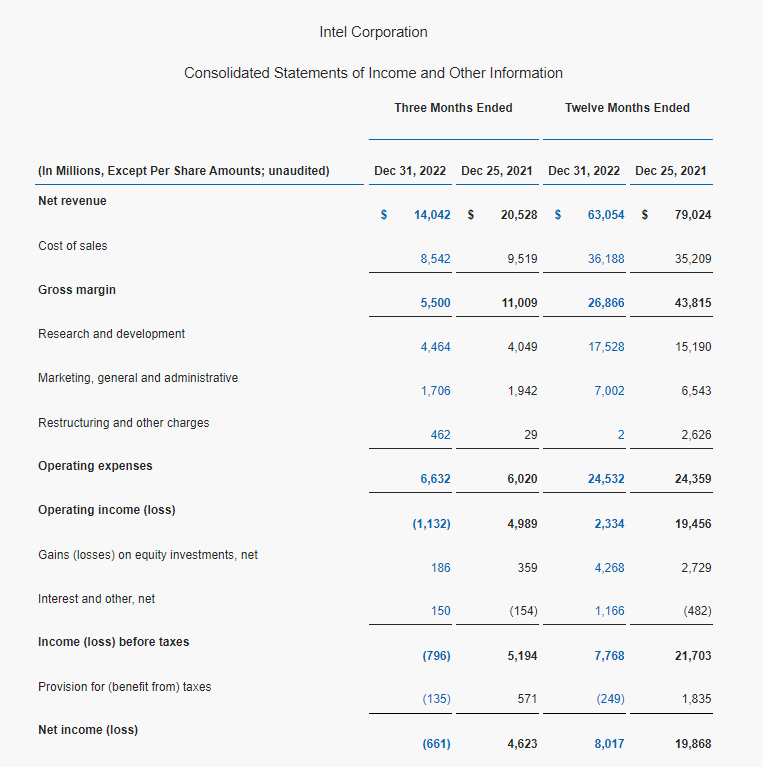
The Scalability Problem
MLID shared a chart featuring various dies from Intel and AMD. The goal of this chart is to show how well AMD’s dies can scale, whereas Intel has to design a specific die for every niche or major segment. To understand the chart, match the colors of each cell on the right with the cells on the left.
Zen4, as you probably know features a performance core (Zen4) and an efficient core (Zen4C) variant. Since AMD uses chiplets, where 8-cores are packed into 1 CCD, Zen4 (on Desktop/Threadripper/Server/Laptop) requires just 1 base CCD. Zen4C requires another type of CCD (16 Zen4C cores / 1 CCD), which is expected to be used in Bergamo and Siena (Not to be confused with Intel’s Sierra Forest).
After that, you just need one IOD (I/O Die) for the EPYC processors and one IOD for the base Ryzen processors. So team red requires just 4 base dies to scale across almost every segment of the market.
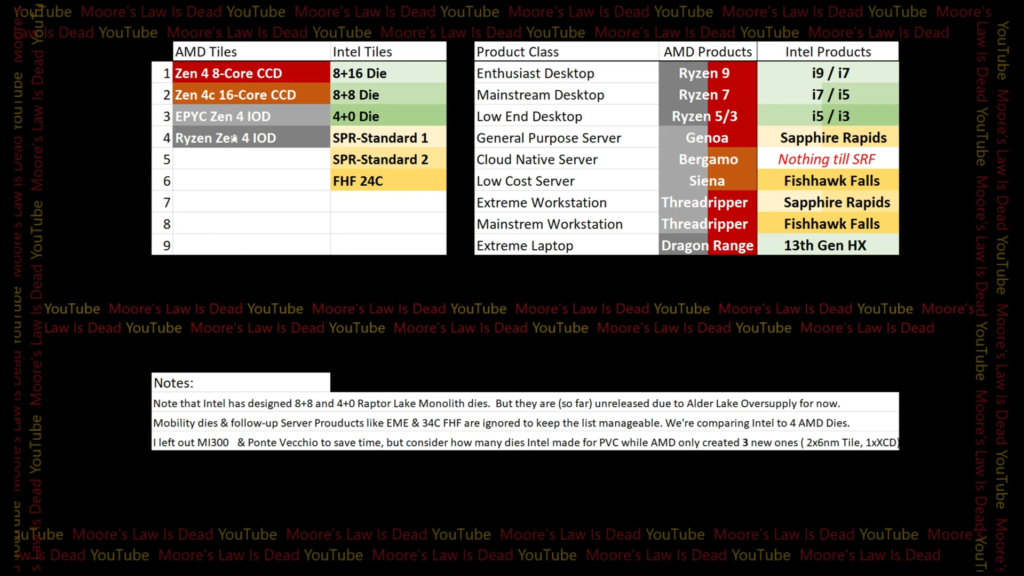
Intel, on the other hand, has 3 RPL-S dies (8+16, 8+8, 4+0) for their i3/i5/i7 and i9 families. Then for general-purpose servers and extreme workstations (see the chart for more clarity), the giant has designed two different SPR (Sapphire Rapids) dies. It gets worse. The mainstream workstation (W-2400) CPUs are also based on a separate die, namely the FHF (Fishhawk Falls) 24-core die.
tl;dr Intel has designed 50% more base dies than AMD, which vastly increases the expenses and operating costs. This combined with the fact that their server/workstation offerings are almost 1 generation behind AMD spells trouble for Intel.
Why does it matter? Suppose AMD has an oversupply of a specific die, say Zen4 CCDs. They can simply use the extra inventory on other products such as Dragon Range mobile CPUs or their upcoming Threadripper 7000 HEDT processors. That is the advantage of building a scalable structure.
Battlemage To The Rescue
Interestingly, Battlemage is planned with these problems in mind. Apparently, Arc Battlemage will only feature Xe2-LPG and Xe2-HPG flavors to scale across all segments. This is drastically lower than both AMD & NVIDIA. While scaling 2 architectures may be a hard task, it comes with its own set of benefits.
The Takeaway
If you intend to design multiple variations of a product and expect all of them to launch on time, your main plan (a specific generation) could be delayed for years upon years. Intel learned this the hard way. They are now accepting the bitter reality that they cannot put all resources into a high-end MTL-S chip and expect to launch MTL for laptops at the same time.
This, in fact, is a good thing because team blue will be focusing on its key weaknesses now. One design to rule them all will always be better than a plethora of sub-par variations. Moving forward, the Foveros design will really help Intel scale its CPUs as well as develop new and exciting designs.
Remember the 512-core Sierra Forest CPU that was recently canceled? I wrote that if each e-core consumes as low as 2W, you’d still require 1000W to feed the whole CPU. I’m not saying that Intel is not aware of this. They probably have the best engineers and designers in the world. But the decisions made at the company 3-4 years back and the lack of innovation gave room to AMD and are still biting Intel to this day.
Words Of Optimism
Pat Gelsinger has been optimistic regarding the future of Intel. Do note that he has been the CEO for around 2 years now, so it will still take a while to see some of the architectures created under his leadership.
We have made so much progress in a year and a half, but there is still a lot of work to do. If you ask our top 10 customers, they would say, “Oh, there is a defined shift. They are back to focusing on quality, on engineering, and on giving us transparency on schedules. We are rebuilding our confidence.”
Pet Gelsinger, Intel CEO to The Verge
Intel is still keen on releasing Intel 4 this year, manufacturing 20A in H1 2024 and 18A in H2 2022. Pat Gelsinger is using a paralleled approach where each development team is parallel from one another, to keep the tick-tock execution cycle intact.
It’s actually the opposite. We took too much risk, and we failed. It is a managed risk methodology in that sense. When I came back, we had said we were going to do five nodes in four years, which is an audacious plan to lay out. Even inside of the process of technology development now, it is a very risk-managed, cadence-focused delivery, where we have essentially parallelized the 10-7 team (10nm – Intel 7 processes) from the 4-3 team (Intel 4 – Intel 3 processes) from the 20A and 18A team. These teams may build and leverage each other, but they are parallel, each becoming its own tick-tock execution environment.
Pet Gelsinger, Intel CEO to The Verge
Conclusion
A round of applause to all who made it to the end of this editorial. While our ‘The Takeaway’ section might have been enough to get the point across, let us do a quick recap. 2023 may see Intel lose more market share given the lack of (next-gen) products. However, that will change in Q4 23/Q1 24 with the launch of Meteor Lake. After that, GNR-SP/GNR-AP/SRF-SP/SRF-AP will follow to unleash team blue’s wrath. Not much is precisely known after that, however, Intel is looking to clap back within just a couple of years. Stay tuned at Appuals for more news and leaks.
- Transistor Density Count: Wikipedia/WikiChip
- Leaks & Rumors: Moore’s Law Is Dead
- Pat Gelsinger Quotes: The Verge
- Intel Q4 Earnings: intc
- Leaked Roadmap: HXL
- i5-13400 Listing: PCMR via PPG
- Golden Cove vs Raptor Cove: OneRaichu
- Intel vs AMD Desktop Market Share: cpubenchmark
- Intel Battlemage Xe2 Details: REDTECHGAMING

